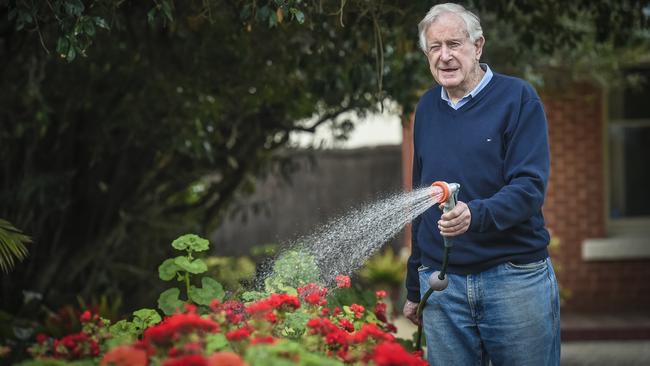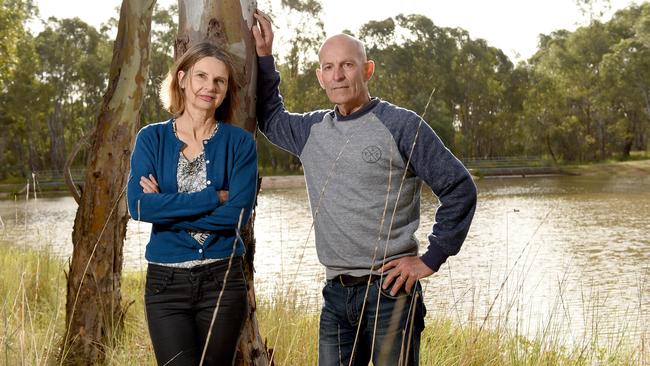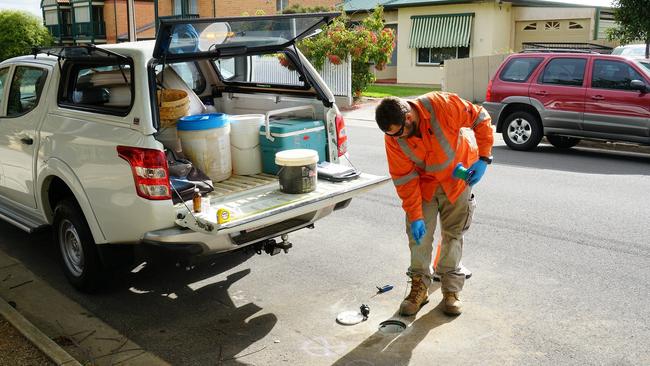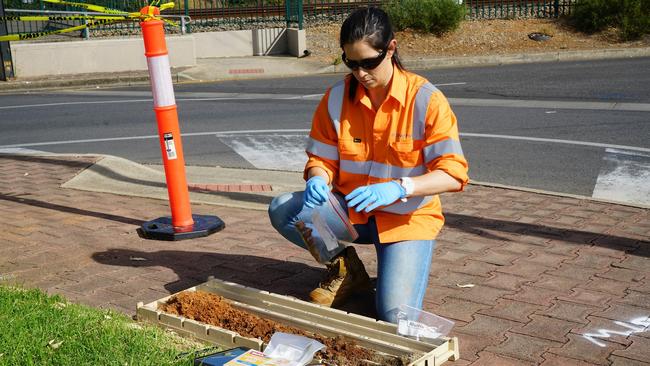Bore water use prohibited in Glenelg, Glenelg East, Glenelg South and Glengowrie because of historic contamination
Glenelg is the latest suburb hit with a ban on bore water, which is likely to remain in place for a century, and it won’t be the last, because Adelaide is littered with contaminated sites.
SA News
Don't miss out on the headlines from SA News. Followed categories will be added to My News.
Glenelg is the latest suburb hit with a ban on bore water, which is likely to remain in place for a century – and it won’t be the last.
Adelaide is littered with contaminated sites, a legacy of past industrial use. Discarded chemicals have seeped into the soil and leeched into groundwater.
The groundwater in shallow aquifers beneath Glenelg East and Glenelg is so contaminated that it must not be used for any purpose.
Anyone caught using bore water in these areas risks a fine of up to $8000. They also put their health at risk.
Neighbouring suburbs of Glenelg South and Glengowrie have been included in the ban, to help avoid spreading the contamination further.
The Groundwater Prohibition Area comes into effect on Thursday, but the Environment Protection Authority told residents to stop using bore water months ago.
EPA regulation director Peter Dolan says residents may also be exposed to health risks from vapour entering buildings through cracks in floorboards or concrete slabs.
“Basements may have an elevated risk from vapour because they are closer to the groundwater, so we are encouraging anyone with underground rooms to get in touch with the EPA,” he said.
Historical use of chemicals at a former dry cleaning business on Cliff St, Glenelg East has contaminated groundwater with the industrial solvents perchloroethene (PCE) and trichloroethene (TCE).
Other chemicals include petroleum hydrocarbons from degraded underground storage tanks at a service station, and heavy metals and cyanide from a former blacksmith’s forge.
These compounds can cause health problems if people are exposed to high enough concentrations over long periods of time.

The EPA has already established Groundwater Prohibition Areas in Edwardstown and the surrounding suburbs, and the Allenby Gardens/Flinders Park area.
When it comes to the sale of property within these areas, purchasers must be made aware of the prohibition. A notification of an interest held by the EPA must be made on the Form 1 statement. This is a document that must be provided to a prospective buyer before settlement, under section 7 of the Land and Business (Sale and Conveyancing) Act 1994.
Deeper, uncontaminated aquifers are exempt. Residents are encouraged to contact the EPA if they are unsure how deep their bore is.
Glenelg resident Jack Messenger was relieved to discover his bore is “deep enough to escape the prohibition”. “The luck of the draw is how deep your contractor went,” he said.
“During the drought some years ago, we put bores in two of our properties.” He can continue using bore water, for gardening and topping up the swimming pool, while his neighbours cannot.
Mr Dolan said councils and schools would also continue to be able to use bore water for irrigation, because they accessed the much deeper tertiary aquifer.
“There is no problem with the area’s soil, or with eating homegrown produce, so long as it has not been irrigated with bore water,” he said.
Poison in our soil

1 Elizabeth
Soil and groundwater contamination assessment started 1999 at the Holden site, surrounding chemicals used during manufacture and assembly of motor vehicles (TCE, PCE, DCE and VC), ongoing.
2 Parafield Gardens
Groundwater contamination assessment started 2015, petroleum-related hydrocarbons beneath Coles Express service station, remediation site works underway, ongoing.
3 Birkenhead
Groundwater contamination assessment started 2011, arsenic and cyanide from former gasworks site on Mead St, residents advised not to use bore water for drinking, watering fruit or vegetables, and skin contact to be avoided.
4 West Lakes
Soil and groundwater contamination assessment started 1999, regarding use of sewage sludge from the Port Adelaide Wastewater Treatment Plant during the development, residents offered soil testing.
5 Hendon
Soil and groundwater contamination assessment started 2012, for chemicals including TCE and PCE from the former industrial area, vapours in homes tested, found to be within safe levels, but residents advised not to use basements for sleeping.
Soil and groundwater assessment started 2018 in the area formerly known as the ‘Finsbury Factory’ and now known as Woodville North Industrial Complex, focus on TCE and vapour, ongoing.
7 Beverley
Soil and groundwater contamination assessment started 2006, focus on TCE and vapour, residents advised not to use groundwater (bore water) for any purpose. Mitigation work completed by the EPA for homes where vapour intrusion is occurring.
8 Klemzig
Groundwater contamination assessment started regarding petroleum residues near Coles Express service station, seven landholders asked to complete a survey of groundwater use and confirm the presence of basements/underground cellars in the area.
9 Allenby Gardens
Groundwater contamination assessment restarted 2013 (VCE, DCE and VC) after an earlier investigation in 2009. Groundwater prohibition area established in July 2016.
10 Thebarton
Groundwater contamination assessment started 2017, after TCE was found in the vicinity of a former metal processing site on George St, included indoor air sampling for vapours, six homes required mitigation systems.
11 Marleston
Groundwater contamination assessment started 2010, focus on TCE, PCE and DCE near Marleston TAFE, included soil vapour sampling, extensive plume has spread offsite.
12 Keswick
Soil and groundwater contamination assessment started 2017 for chemicals including TCE from the former Kelvinator sites in Everard Ave, all residential homes in the assessment area deemed safe from the risk of TCE vapour indoors, but groundwater not to be used for any purpose.
13 Unley
groundwater contamination assessment started 2017, recognising historical land uses including refrigeration manufacturing, furniture manufacturing, cabinet making, boot making and a drapery, houses deemed safe from soil vapour, residents not to use groundwater for any purpose.
14 Glenelg
Groundwater contamination assessment started 2011, chemicals including PCE, TCE and DCE from former dry cleaners, indoor soil vapours tested at levels not requiring action. Groundwater prohibition area established in December 2018. Residents not to use groundwater for any purpose.
15 Edwardstown
Soil and groundwater contamination (TCE, DCE) identified 1997 at former automotive components facility, jointly owned by Bridgestone Australia Ltd and Toyoda Gosei Ltd. Also TCE plume originating from the former Hills site. Groundwater prohibition area established in January 2018. Residents not to use groundwater for any purpose.
16 Brighton
Soil vapour contamination (TCE, PCE) assessment started February 2018 during redevelopment of a commercial site. Dry cleaning premises on Brighton Rd the most likely source. Testing underway, report expected in January 2019.
17 Clovelly Park/Mitchell Park
Soil and groundwater contamination assessment started 2012 around former Mitsubishi Motors site and other industrial sources of TCE, including soil vapour testing, required relocation and demolition of Housing SA and two private properties as a precaution.
18 Seacliff
Assessment started 2010 for landfill gas in homes in the Seacliff, Kingston Park and Marino area, none detected.
The bore war

Residents all over Adelaide are learning to live with the troubling reality that their property, the soil and water beneath their feet, may be contaminated.
More than 2200 South Australian sites are listed on the public register and that number continues to grow as more sites are discovered and reported to the Environment Protection Authority.
EPA regulation director Peter Dolan says he'd like to think we've already got the big ones. “I think we will run out of large sites,” he says.
“As you expect, we prioritise our work, we clearly want to make sure people are protected, so we focus on sites where people are using groundwater, or most residents are affected, or potentially affected.”
Ascot Park mother of four Melissa McNab lives in the Edwardstown assessment area and maintains an interest in ongoing works three years after the investigation began.
“The contamination levels are quite low in my street, so it's nothing to be worried about, but I'm still concerned,” she says.
“You don't know what's going to happen in the future. Will they say ‘Oh sorry, actually we got it wrong’? I definitely wouldn't be using bore water in the area, that's for sure.”
The EPA works with SA Health to make science-based assessments on the potential for human health risk.
Regulators can revisit the register and review all the documentation on file as the need arises.
That happened after 2011 as the global scientific community began to understand the implications of vapours rising through contaminated soils into indoor air spaces.
Before the Clovelly Park site assessment began in 2012, vapour hadn't been seen as a risk in Adelaide and the focus was on groundwater.
Then the risk was found to be so great that 23 residents were offered relocation, as a precaution. The EPA, on behalf of government, then undertook further assessment of about 1400 properties.
In 2014, the EPA engaged a consultant to review the Beverley site contamination assessment area, to see if the same problem was occurring there. Other sites followed.

SA Health now has an indoor air level response range for the industrial solvent TCE and the EPA has a mitigation strategy that involves fanning polluted air out of buildings, rather than tearing them down.
Site contamination is the unfortunate consequence of poor waste management practices in days gone by.
People commonly poured leftover solvents onto the ground, assuming the chemicals would evaporate, rather than leach into the soil and shallow groundwater.
Some solvents float on the water, while others sink and lie beneath it.
In all cases small amounts of the chemical mix into the water. “It's extraordinarily difficult to pull out enough water to reduce the amount of solvent in the groundwater,” Mr Dolan says. “It's so expensive that it would be ridiculous, so what we do for these sites is we work toward removal of the source, so any soils or contaminants, or tanks that might be the source, get removed.
“That's signed off by an auditor, so the source is cleaned up as much as we can and that means there's no more going in to the groundwater.
“Then over time it will break down, over tens of years or hundreds of years and there's little point doing much other than banning people using groundwater.”
Groundwater prohibition areas include Allenby Gardens, Edwardstown and Glenelg East. A maximum fine of $8000 applies for anyone using groundwater from these contaminated aquifers. There is also a moratorium on the installation of new bores in Adelaide and many other bores are disappearing in the process of subdivision and urban infill.
As a rule, no-one should use groundwater for any purpose without having it tested on a regular basis.
The Australian Water Quality Centre has reduced residential testing rates, starting at $438 plus GST for analysis and collection of one sample. The most common contaminants of concern include:
PETROLEUM hydrocarbons, from service stations and fuel storage.
CHLORINATED hydrocarbons like trichloroethene (TCE), tetrachloroethene (PCE), dichloroethene (DCE) and vinyl chloride (VC) from manufacturing, electroplating, dry-cleaning.
HEXAVALENT chromium, from electroplating.
COPPER, chromium and arsenic from treated timber.
CYANIDE from electroplating and gas works.
POLYCYCLIC aromatic hydrocarbons (PAHs) from timber treatment, gasworks and old asphalt.
PESTICIDES and herbicides.
METALS such as lead and cadmium from manufacturing, old fuels, old sewage sludge and foundries.
PFAS (per- and poly-fluoroalkyl substances) from firefighting, fabric treatment and manufacturing.
Health effects vary, depending on the degree of exposure and many other complex factors. Some of these chemicals are known to cause disease such as cancer, others are suspicious and the jury is still out.
Orchid grower and Burton resident Graham Guest is concerned about possible health effects of PFAS contamination from firefighting foams used on the RAAF Edinburgh base.
Residues have been detected in the creek and Kaurna Park Wetland, at the back of his property.
“It's an unfortunate accident, nobody's done it deliberately,” he said.
“However there is a responsibility by RAAF to remedy the situation, given that the contamination has leaked out to properties past the RAAF base.”



